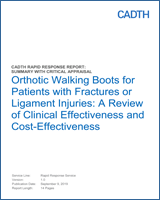| Bauer,10 2019, US | 3 year retrospective chart review The patients initially presented to the emergency department, orthopedic clinic or pediatrician at the investigators’ hospital; or to the emergency department or pediatrician at a different hospital. All these patients were followed up at the orthopedic clinic. | Pediatric patients with isolated, non-displaced spiral tibia fractures with intact fibula, or those without the appearance of any injury (negative radiograph) in order not to miss occult fractures. N = 192 (patients with initial immobilization type: 53 with long leg cast, 83 with short leg cast, 46 with boot, 3 with long leg splint and 7 with none) Age (mean [95% Cl]) (year): 2.04 (1.94 to 2.14) % Female: 27% | CAM walker boots (intervention of interest) compared with long leg cast, short leg cast, long leg splint, and none (i.e., no immobilization) Initial immobilization was with long leg cast in 53 patients, short leg cast in 83 patients, and boot in 46 patients. Twenty-three patients with the long leg cast and 28 patients with the short leg cast changed to boot after a mean duration of 10.9 days and 13.5 days respectively. Also, 19 patients with the long leg cast and 2 patients with the boot changed to the short leg cast after a mean duration of 8.7 days and 10.5 days respectively. Reasons for change were not presented. This resulted in final immobilization with the long cast, short leg cast, and boot in 11, 77, and 97 patients respectively Ten different physicians treated the children. The immobilization type and duration were based on the clinical judgement of the attending physician. Generally, decision to discontinue immobilization was based on the patient’s ability to weight-bear in the clinic or by the family’s report. | Time duration to return to weight bearing, and complications Duration of follow up: not explicitly stated (results reported up to 6 weeks) |
| Amaha,9 2017, Japan | Retrospective study - review of medical records of patients who underwent surgery for ankle fracture at a single hospital in Japan, between January 2008 and October 2014 | Adult patients who had undergone surgery for an unstable ankle fracture. The surgical procedure entailed an open reduction and an internal fixation. N = 47 (22 in WB group, and 25 in PC group) Age (mean ± SD) (years): 53.9 ± 11.9 for WB, and 43.8 ± 16.1 for PC (P = 0.026). % Female: 50% in WB, 56% in PC. | Walking boot (WB) with a rocker bottom design (Bledsoe walking boot) compared to plaster cast (PC). WB had an adjustable heel lift, which allowed the user to change the ankle position to facilitate walking with a post-operative swollen ankle. | Time duration for improvement at various stages; ROM; loss of reduction; nonunion. Duration of follow-up at least 6 weeks |
| Schuh,6 2016, US | Retrospective study of patients in the age range of 9 months to 3 years presenting at the pediatric emergency department at Seattle’s children’s hospital between January 1, 2008 to December 31, 2012. | Pediatric patients with radiographic evidence of toddler’s fracture N = 75 (18 with CAM boots, 50 with cast or splint, and 7 with no immobilization) Age (month) (mean ± SD): 11 ± 61.1, in boot group; 34 ± 68.0 in the cast/splint group; and 3 ± 42.9 in the immobilization group. % Female: 32% in boot group, 39% in the cast/splint group, and 57% in the immobilization group. | CAM boots (intervention of interest) compared with cast or splint or with no immobilization. Method of immobilization used was at the discretion of the treatment provider. | Duration of immobilization, number of follow-up orthopedic visits, change in therapy at follow-up, number of repeat radiographs, return to emergency department after initial treatment, and complications. Duration of follow-up: not reported |
